Managerial Accounting: Evaluating Departmental Financial Performance
VerifiedAdded on 2023/05/28
|9
|2015
|249
Homework Assignment
AI Summary
This assignment solution addresses managerial accounting principles through two primary problems. The first problem involves allocating indirect expenses to two departments based on specified criteria, such as sales and square footage, to determine each department's net income and assess profitability. It concludes that while one department shows a net loss, discontinuing it may not be beneficial due to the absorption of indirect expenses. The second problem focuses on a three-column report analyzing expenses, a forecasted income statement reflecting the elimination of a department, and a reconciliation of net income, ultimately advising against the department's elimination due to avoidable expenses exceeding lost revenue. The assignment utilizes various accounting techniques and financial analyses to evaluate departmental performance and inform strategic decisions.
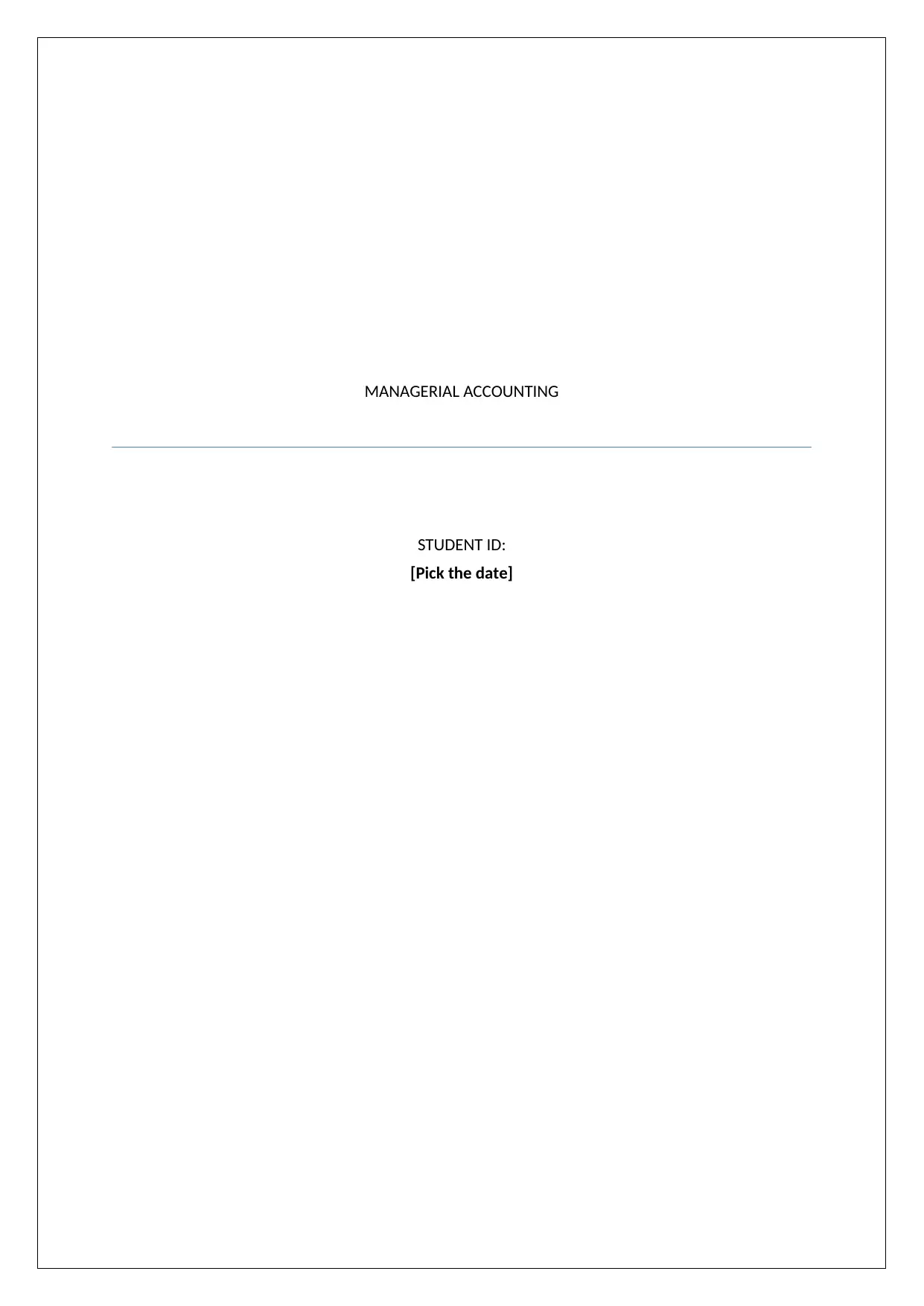
MANAGERIAL ACCOUNTING
STUDENT ID:
[Pick the date]
STUDENT ID:
[Pick the date]
Paraphrase This Document
Need a fresh take? Get an instant paraphrase of this document with our AI Paraphraser
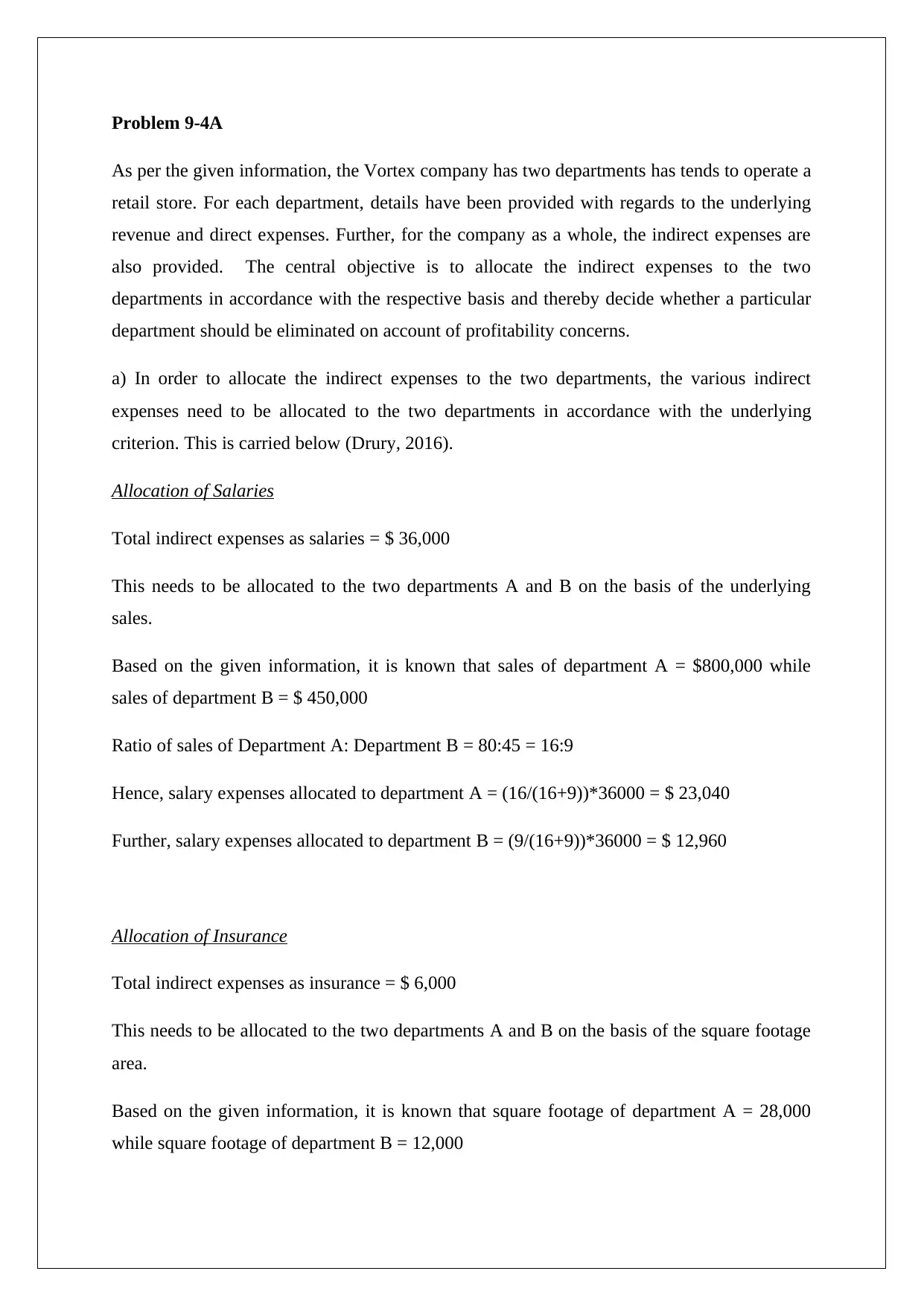
Problem 9-4A
As per the given information, the Vortex company has two departments has tends to operate a
retail store. For each department, details have been provided with regards to the underlying
revenue and direct expenses. Further, for the company as a whole, the indirect expenses are
also provided. The central objective is to allocate the indirect expenses to the two
departments in accordance with the respective basis and thereby decide whether a particular
department should be eliminated on account of profitability concerns.
a) In order to allocate the indirect expenses to the two departments, the various indirect
expenses need to be allocated to the two departments in accordance with the underlying
criterion. This is carried below (Drury, 2016).
Allocation of Salaries
Total indirect expenses as salaries = $ 36,000
This needs to be allocated to the two departments A and B on the basis of the underlying
sales.
Based on the given information, it is known that sales of department A = $800,000 while
sales of department B = $ 450,000
Ratio of sales of Department A: Department B = 80:45 = 16:9
Hence, salary expenses allocated to department A = (16/(16+9))*36000 = $ 23,040
Further, salary expenses allocated to department B = (9/(16+9))*36000 = $ 12,960
Allocation of Insurance
Total indirect expenses as insurance = $ 6,000
This needs to be allocated to the two departments A and B on the basis of the square footage
area.
Based on the given information, it is known that square footage of department A = 28,000
while square footage of department B = 12,000
As per the given information, the Vortex company has two departments has tends to operate a
retail store. For each department, details have been provided with regards to the underlying
revenue and direct expenses. Further, for the company as a whole, the indirect expenses are
also provided. The central objective is to allocate the indirect expenses to the two
departments in accordance with the respective basis and thereby decide whether a particular
department should be eliminated on account of profitability concerns.
a) In order to allocate the indirect expenses to the two departments, the various indirect
expenses need to be allocated to the two departments in accordance with the underlying
criterion. This is carried below (Drury, 2016).
Allocation of Salaries
Total indirect expenses as salaries = $ 36,000
This needs to be allocated to the two departments A and B on the basis of the underlying
sales.
Based on the given information, it is known that sales of department A = $800,000 while
sales of department B = $ 450,000
Ratio of sales of Department A: Department B = 80:45 = 16:9
Hence, salary expenses allocated to department A = (16/(16+9))*36000 = $ 23,040
Further, salary expenses allocated to department B = (9/(16+9))*36000 = $ 12,960
Allocation of Insurance
Total indirect expenses as insurance = $ 6,000
This needs to be allocated to the two departments A and B on the basis of the square footage
area.
Based on the given information, it is known that square footage of department A = 28,000
while square footage of department B = 12,000
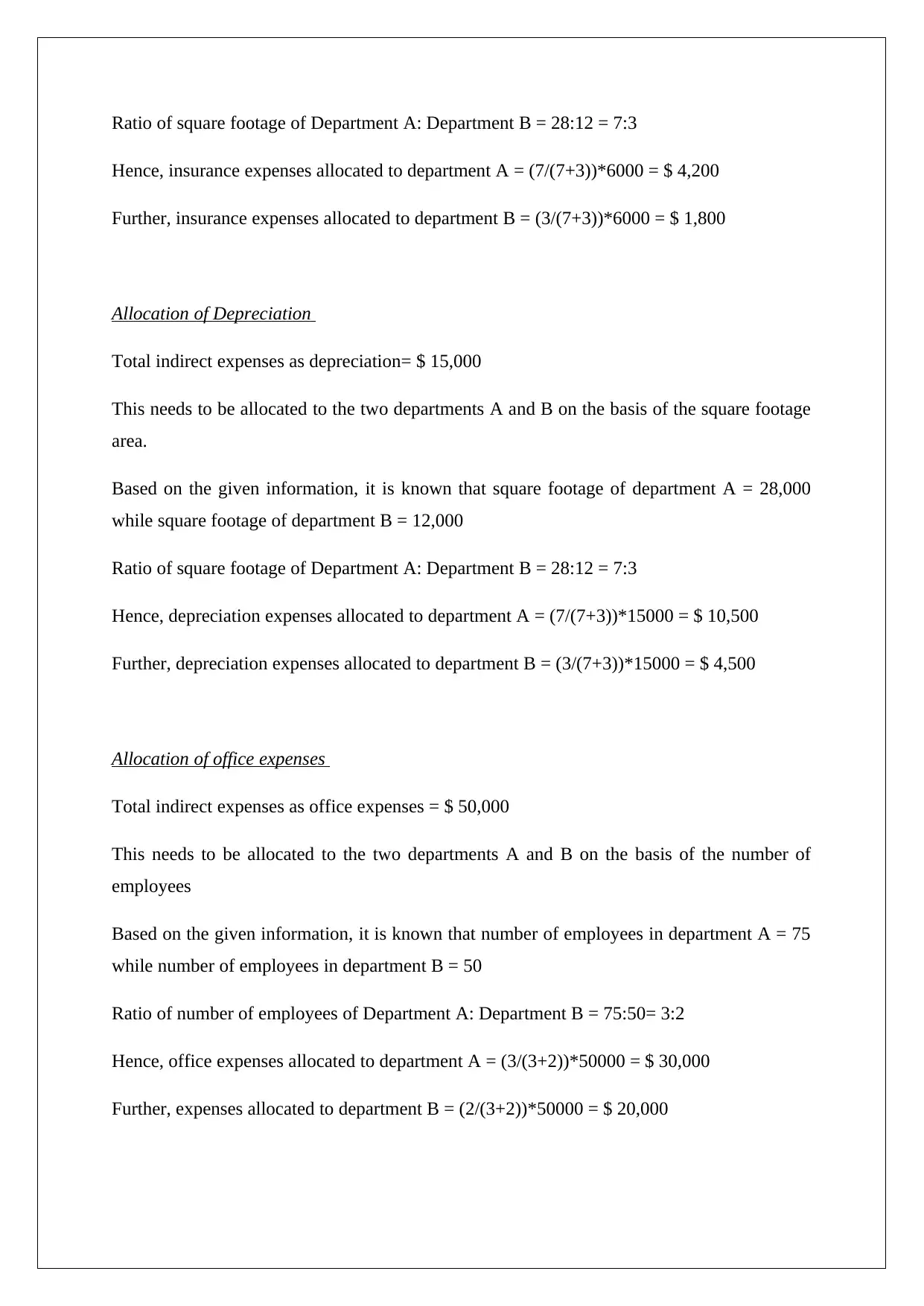
Ratio of square footage of Department A: Department B = 28:12 = 7:3
Hence, insurance expenses allocated to department A = (7/(7+3))*6000 = $ 4,200
Further, insurance expenses allocated to department B = (3/(7+3))*6000 = $ 1,800
Allocation of Depreciation
Total indirect expenses as depreciation= $ 15,000
This needs to be allocated to the two departments A and B on the basis of the square footage
area.
Based on the given information, it is known that square footage of department A = 28,000
while square footage of department B = 12,000
Ratio of square footage of Department A: Department B = 28:12 = 7:3
Hence, depreciation expenses allocated to department A = (7/(7+3))*15000 = $ 10,500
Further, depreciation expenses allocated to department B = (3/(7+3))*15000 = $ 4,500
Allocation of office expenses
Total indirect expenses as office expenses = $ 50,000
This needs to be allocated to the two departments A and B on the basis of the number of
employees
Based on the given information, it is known that number of employees in department A = 75
while number of employees in department B = 50
Ratio of number of employees of Department A: Department B = 75:50= 3:2
Hence, office expenses allocated to department A = (3/(3+2))*50000 = $ 30,000
Further, expenses allocated to department B = (2/(3+2))*50000 = $ 20,000
Hence, insurance expenses allocated to department A = (7/(7+3))*6000 = $ 4,200
Further, insurance expenses allocated to department B = (3/(7+3))*6000 = $ 1,800
Allocation of Depreciation
Total indirect expenses as depreciation= $ 15,000
This needs to be allocated to the two departments A and B on the basis of the square footage
area.
Based on the given information, it is known that square footage of department A = 28,000
while square footage of department B = 12,000
Ratio of square footage of Department A: Department B = 28:12 = 7:3
Hence, depreciation expenses allocated to department A = (7/(7+3))*15000 = $ 10,500
Further, depreciation expenses allocated to department B = (3/(7+3))*15000 = $ 4,500
Allocation of office expenses
Total indirect expenses as office expenses = $ 50,000
This needs to be allocated to the two departments A and B on the basis of the number of
employees
Based on the given information, it is known that number of employees in department A = 75
while number of employees in department B = 50
Ratio of number of employees of Department A: Department B = 75:50= 3:2
Hence, office expenses allocated to department A = (3/(3+2))*50000 = $ 30,000
Further, expenses allocated to department B = (2/(3+2))*50000 = $ 20,000
⊘ This is a preview!⊘
Do you want full access?
Subscribe today to unlock all pages.

Trusted by 1+ million students worldwide
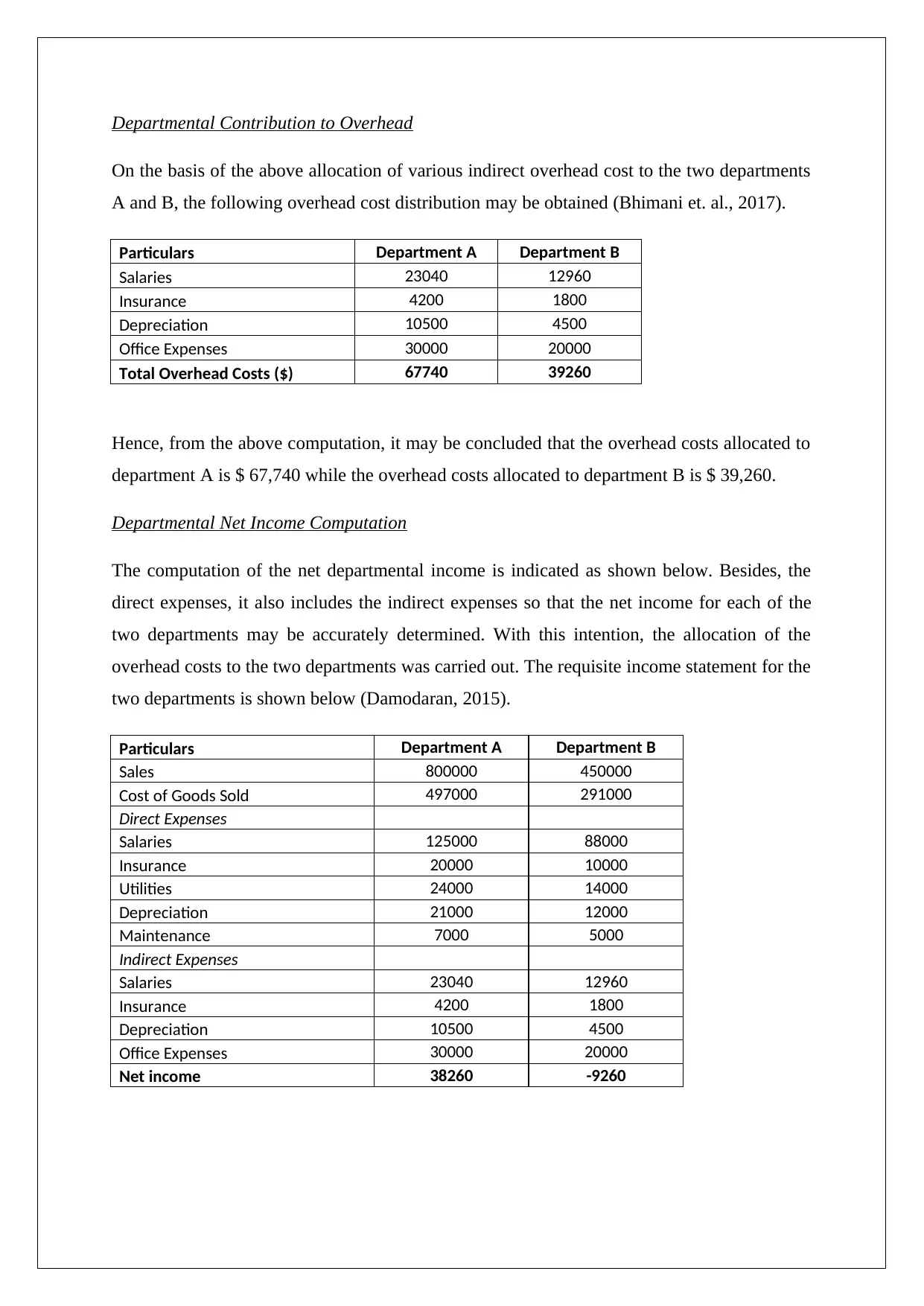
Departmental Contribution to Overhead
On the basis of the above allocation of various indirect overhead cost to the two departments
A and B, the following overhead cost distribution may be obtained (Bhimani et. al., 2017).
Particulars Department A Department B
Salaries 23040 12960
Insurance 4200 1800
Depreciation 10500 4500
Office Expenses 30000 20000
Total Overhead Costs ($) 67740 39260
Hence, from the above computation, it may be concluded that the overhead costs allocated to
department A is $ 67,740 while the overhead costs allocated to department B is $ 39,260.
Departmental Net Income Computation
The computation of the net departmental income is indicated as shown below. Besides, the
direct expenses, it also includes the indirect expenses so that the net income for each of the
two departments may be accurately determined. With this intention, the allocation of the
overhead costs to the two departments was carried out. The requisite income statement for the
two departments is shown below (Damodaran, 2015).
Particulars Department A Department B
Sales 800000 450000
Cost of Goods Sold 497000 291000
Direct Expenses
Salaries 125000 88000
Insurance 20000 10000
Utilities 24000 14000
Depreciation 21000 12000
Maintenance 7000 5000
Indirect Expenses
Salaries 23040 12960
Insurance 4200 1800
Depreciation 10500 4500
Office Expenses 30000 20000
Net income 38260 -9260
On the basis of the above allocation of various indirect overhead cost to the two departments
A and B, the following overhead cost distribution may be obtained (Bhimani et. al., 2017).
Particulars Department A Department B
Salaries 23040 12960
Insurance 4200 1800
Depreciation 10500 4500
Office Expenses 30000 20000
Total Overhead Costs ($) 67740 39260
Hence, from the above computation, it may be concluded that the overhead costs allocated to
department A is $ 67,740 while the overhead costs allocated to department B is $ 39,260.
Departmental Net Income Computation
The computation of the net departmental income is indicated as shown below. Besides, the
direct expenses, it also includes the indirect expenses so that the net income for each of the
two departments may be accurately determined. With this intention, the allocation of the
overhead costs to the two departments was carried out. The requisite income statement for the
two departments is shown below (Damodaran, 2015).
Particulars Department A Department B
Sales 800000 450000
Cost of Goods Sold 497000 291000
Direct Expenses
Salaries 125000 88000
Insurance 20000 10000
Utilities 24000 14000
Depreciation 21000 12000
Maintenance 7000 5000
Indirect Expenses
Salaries 23040 12960
Insurance 4200 1800
Depreciation 10500 4500
Office Expenses 30000 20000
Net income 38260 -9260
Paraphrase This Document
Need a fresh take? Get an instant paraphrase of this document with our AI Paraphraser
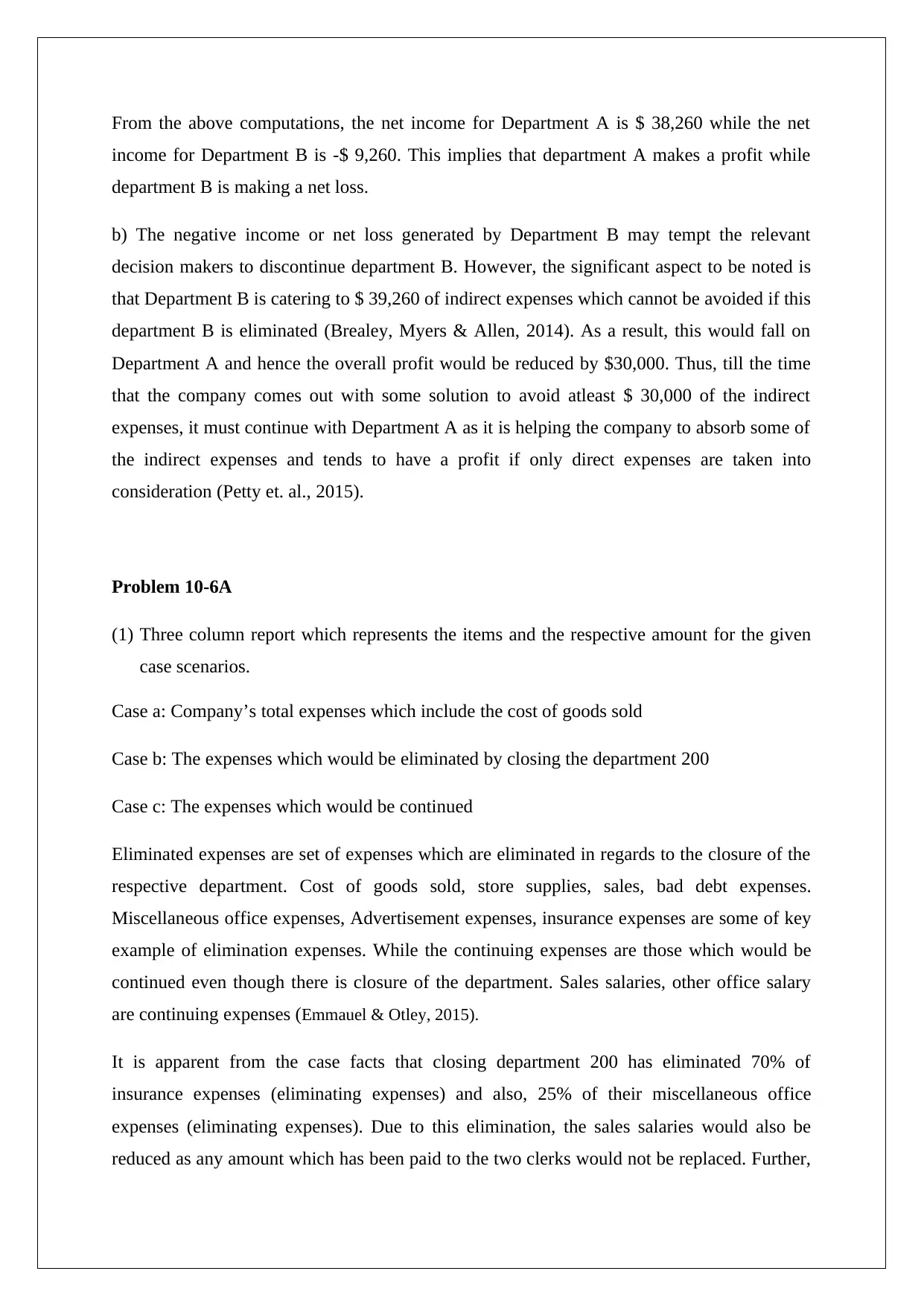
From the above computations, the net income for Department A is $ 38,260 while the net
income for Department B is -$ 9,260. This implies that department A makes a profit while
department B is making a net loss.
b) The negative income or net loss generated by Department B may tempt the relevant
decision makers to discontinue department B. However, the significant aspect to be noted is
that Department B is catering to $ 39,260 of indirect expenses which cannot be avoided if this
department B is eliminated (Brealey, Myers & Allen, 2014). As a result, this would fall on
Department A and hence the overall profit would be reduced by $30,000. Thus, till the time
that the company comes out with some solution to avoid atleast $ 30,000 of the indirect
expenses, it must continue with Department A as it is helping the company to absorb some of
the indirect expenses and tends to have a profit if only direct expenses are taken into
consideration (Petty et. al., 2015).
Problem 10-6A
(1) Three column report which represents the items and the respective amount for the given
case scenarios.
Case a: Company’s total expenses which include the cost of goods sold
Case b: The expenses which would be eliminated by closing the department 200
Case c: The expenses which would be continued
Eliminated expenses are set of expenses which are eliminated in regards to the closure of the
respective department. Cost of goods sold, store supplies, sales, bad debt expenses.
Miscellaneous office expenses, Advertisement expenses, insurance expenses are some of key
example of elimination expenses. While the continuing expenses are those which would be
continued even though there is closure of the department. Sales salaries, other office salary
are continuing expenses (Emmauel & Otley, 2015).
It is apparent from the case facts that closing department 200 has eliminated 70% of
insurance expenses (eliminating expenses) and also, 25% of their miscellaneous office
expenses (eliminating expenses). Due to this elimination, the sales salaries would also be
reduced as any amount which has been paid to the two clerks would not be replaced. Further,
income for Department B is -$ 9,260. This implies that department A makes a profit while
department B is making a net loss.
b) The negative income or net loss generated by Department B may tempt the relevant
decision makers to discontinue department B. However, the significant aspect to be noted is
that Department B is catering to $ 39,260 of indirect expenses which cannot be avoided if this
department B is eliminated (Brealey, Myers & Allen, 2014). As a result, this would fall on
Department A and hence the overall profit would be reduced by $30,000. Thus, till the time
that the company comes out with some solution to avoid atleast $ 30,000 of the indirect
expenses, it must continue with Department A as it is helping the company to absorb some of
the indirect expenses and tends to have a profit if only direct expenses are taken into
consideration (Petty et. al., 2015).
Problem 10-6A
(1) Three column report which represents the items and the respective amount for the given
case scenarios.
Case a: Company’s total expenses which include the cost of goods sold
Case b: The expenses which would be eliminated by closing the department 200
Case c: The expenses which would be continued
Eliminated expenses are set of expenses which are eliminated in regards to the closure of the
respective department. Cost of goods sold, store supplies, sales, bad debt expenses.
Miscellaneous office expenses, Advertisement expenses, insurance expenses are some of key
example of elimination expenses. While the continuing expenses are those which would be
continued even though there is closure of the department. Sales salaries, other office salary
are continuing expenses (Emmauel & Otley, 2015).
It is apparent from the case facts that closing department 200 has eliminated 70% of
insurance expenses (eliminating expenses) and also, 25% of their miscellaneous office
expenses (eliminating expenses). Due to this elimination, the sales salaries would also be
reduced as any amount which has been paid to the two clerks would not be replaced. Further,
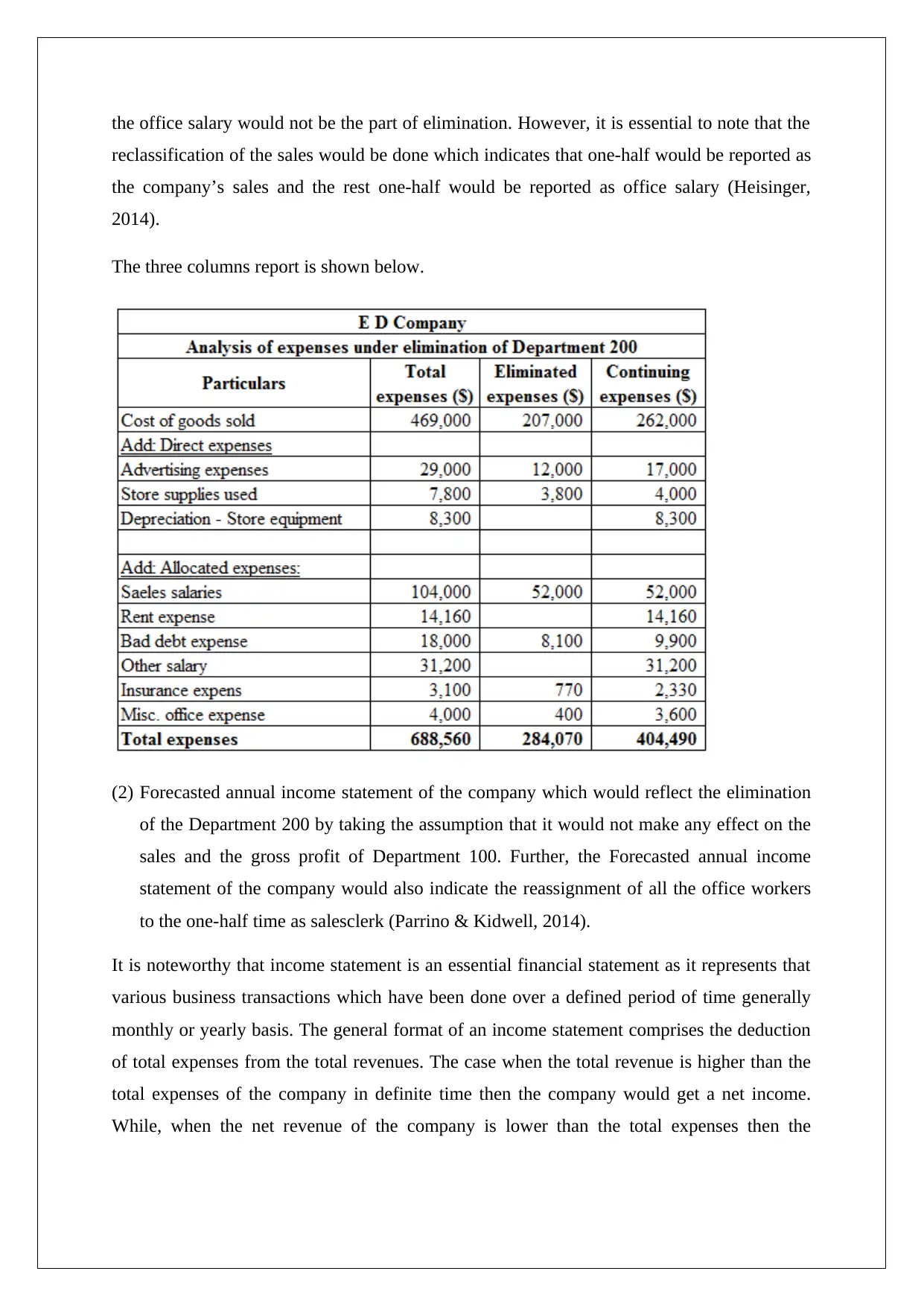
the office salary would not be the part of elimination. However, it is essential to note that the
reclassification of the sales would be done which indicates that one-half would be reported as
the company’s sales and the rest one-half would be reported as office salary (Heisinger,
2014).
The three columns report is shown below.
(2) Forecasted annual income statement of the company which would reflect the elimination
of the Department 200 by taking the assumption that it would not make any effect on the
sales and the gross profit of Department 100. Further, the Forecasted annual income
statement of the company would also indicate the reassignment of all the office workers
to the one-half time as salesclerk (Parrino & Kidwell, 2014).
It is noteworthy that income statement is an essential financial statement as it represents that
various business transactions which have been done over a defined period of time generally
monthly or yearly basis. The general format of an income statement comprises the deduction
of total expenses from the total revenues. The case when the total revenue is higher than the
total expenses of the company in definite time then the company would get a net income.
While, when the net revenue of the company is lower than the total expenses then the
reclassification of the sales would be done which indicates that one-half would be reported as
the company’s sales and the rest one-half would be reported as office salary (Heisinger,
2014).
The three columns report is shown below.
(2) Forecasted annual income statement of the company which would reflect the elimination
of the Department 200 by taking the assumption that it would not make any effect on the
sales and the gross profit of Department 100. Further, the Forecasted annual income
statement of the company would also indicate the reassignment of all the office workers
to the one-half time as salesclerk (Parrino & Kidwell, 2014).
It is noteworthy that income statement is an essential financial statement as it represents that
various business transactions which have been done over a defined period of time generally
monthly or yearly basis. The general format of an income statement comprises the deduction
of total expenses from the total revenues. The case when the total revenue is higher than the
total expenses of the company in definite time then the company would get a net income.
While, when the net revenue of the company is lower than the total expenses then the
⊘ This is a preview!⊘
Do you want full access?
Subscribe today to unlock all pages.

Trusted by 1+ million students worldwide
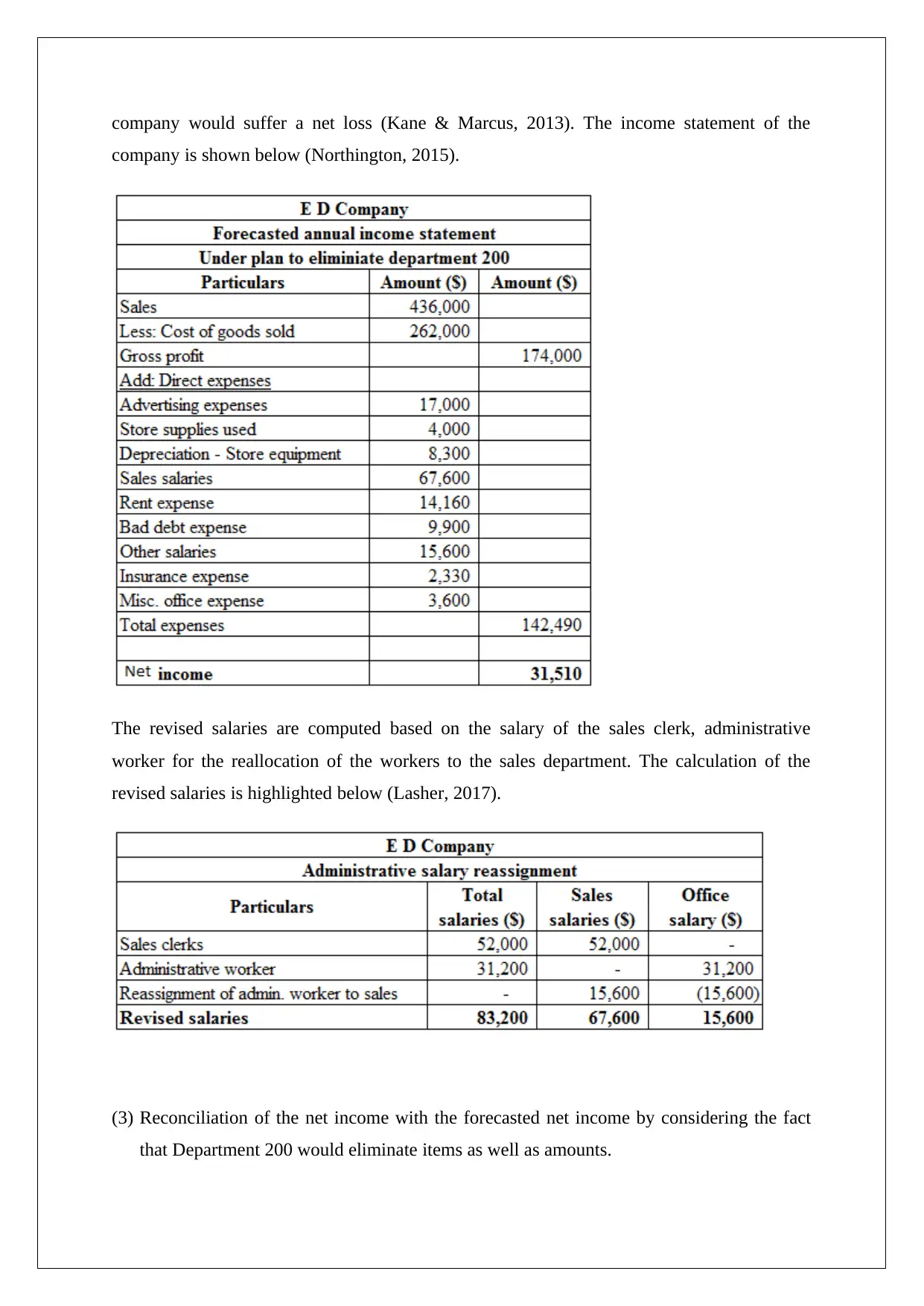
company would suffer a net loss (Kane & Marcus, 2013). The income statement of the
company is shown below (Northington, 2015).
The revised salaries are computed based on the salary of the sales clerk, administrative
worker for the reallocation of the workers to the sales department. The calculation of the
revised salaries is highlighted below (Lasher, 2017).
(3) Reconciliation of the net income with the forecasted net income by considering the fact
that Department 200 would eliminate items as well as amounts.
company is shown below (Northington, 2015).
The revised salaries are computed based on the salary of the sales clerk, administrative
worker for the reallocation of the workers to the sales department. The calculation of the
revised salaries is highlighted below (Lasher, 2017).
(3) Reconciliation of the net income with the forecasted net income by considering the fact
that Department 200 would eliminate items as well as amounts.
Paraphrase This Document
Need a fresh take? Get an instant paraphrase of this document with our AI Paraphraser
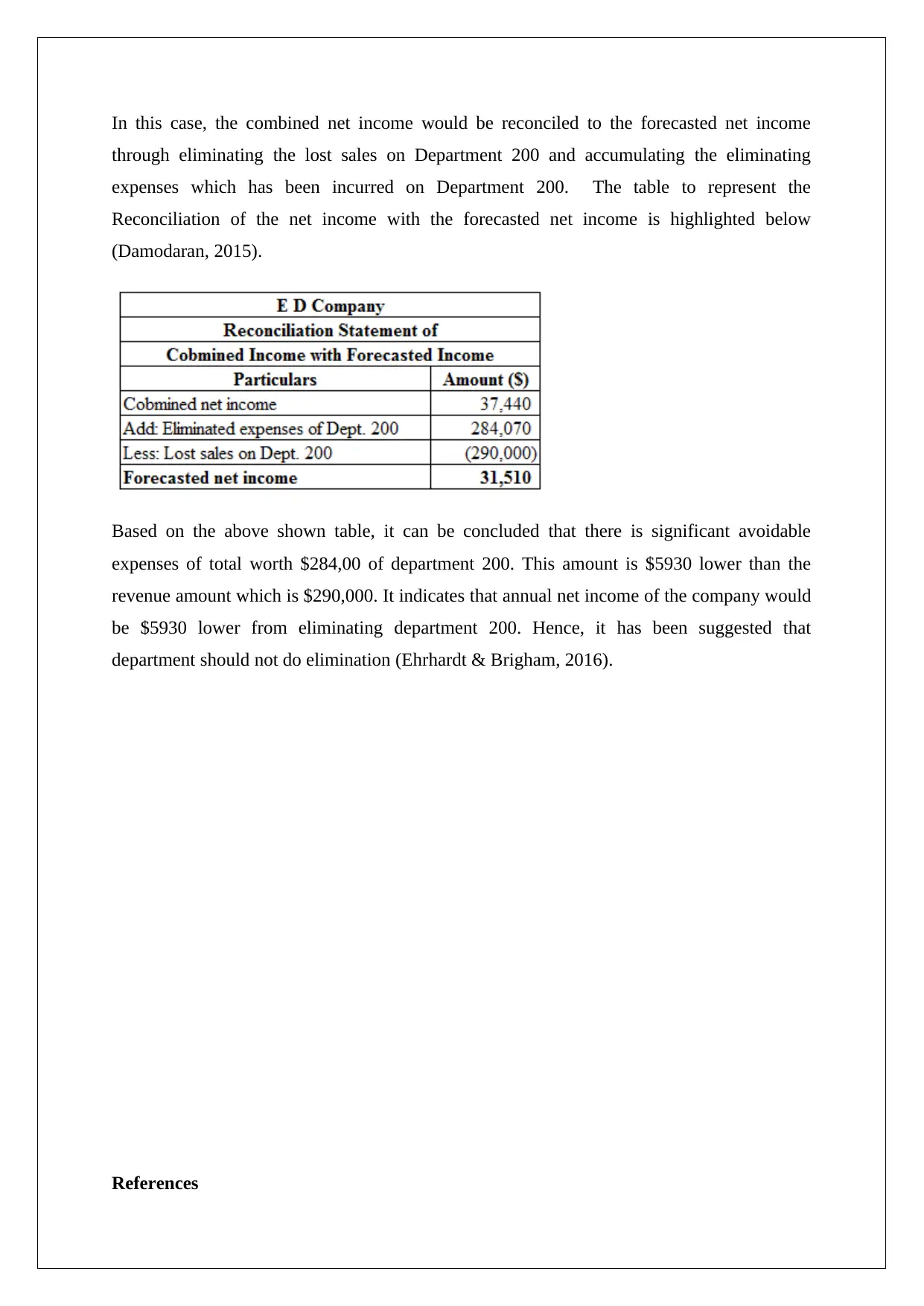
In this case, the combined net income would be reconciled to the forecasted net income
through eliminating the lost sales on Department 200 and accumulating the eliminating
expenses which has been incurred on Department 200. The table to represent the
Reconciliation of the net income with the forecasted net income is highlighted below
(Damodaran, 2015).
Based on the above shown table, it can be concluded that there is significant avoidable
expenses of total worth $284,00 of department 200. This amount is $5930 lower than the
revenue amount which is $290,000. It indicates that annual net income of the company would
be $5930 lower from eliminating department 200. Hence, it has been suggested that
department should not do elimination (Ehrhardt & Brigham, 2016).
References
through eliminating the lost sales on Department 200 and accumulating the eliminating
expenses which has been incurred on Department 200. The table to represent the
Reconciliation of the net income with the forecasted net income is highlighted below
(Damodaran, 2015).
Based on the above shown table, it can be concluded that there is significant avoidable
expenses of total worth $284,00 of department 200. This amount is $5930 lower than the
revenue amount which is $290,000. It indicates that annual net income of the company would
be $5930 lower from eliminating department 200. Hence, it has been suggested that
department should not do elimination (Ehrhardt & Brigham, 2016).
References
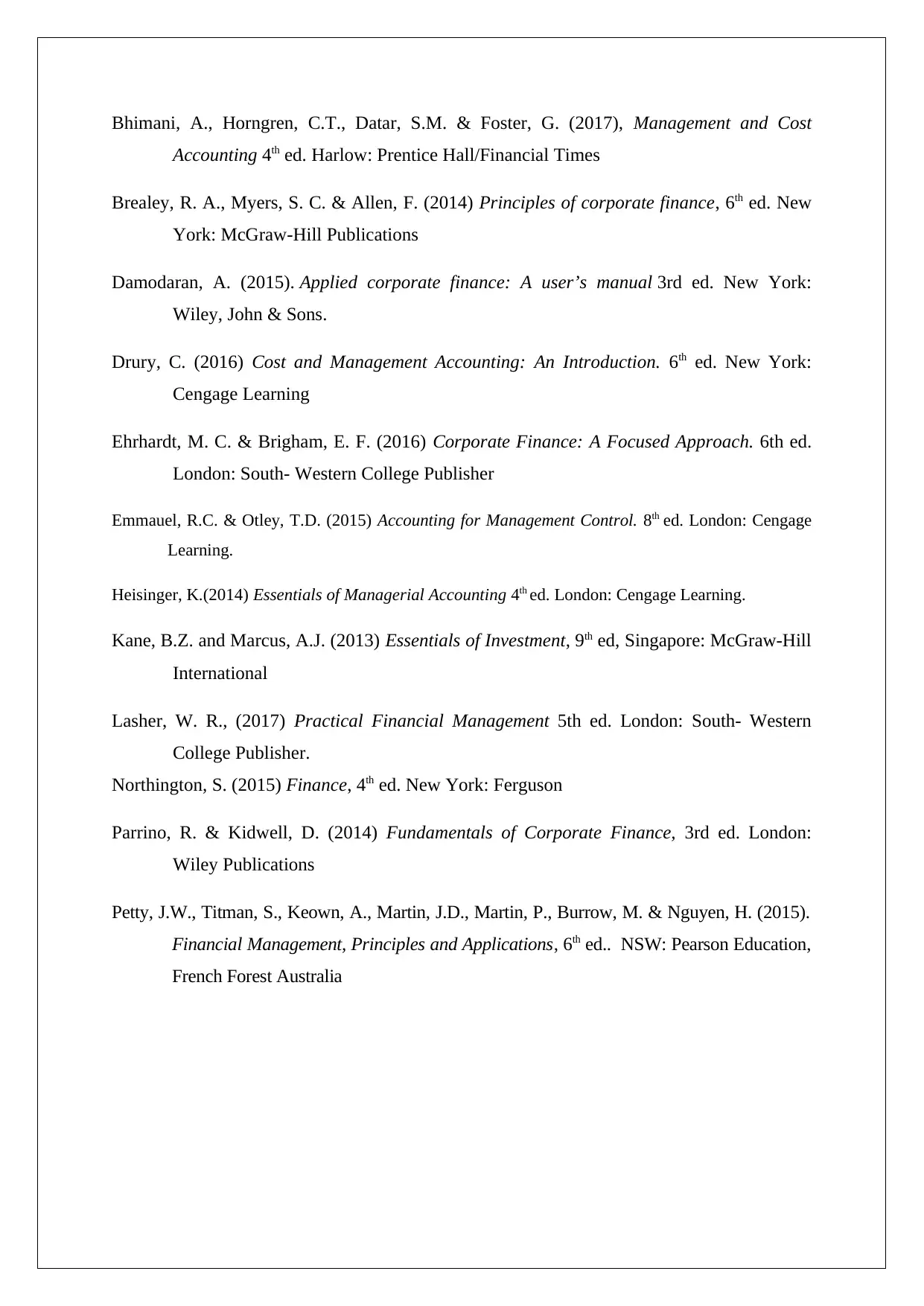
Bhimani, A., Horngren, C.T., Datar, S.M. & Foster, G. (2017), Management and Cost
Accounting 4th ed. Harlow: Prentice Hall/Financial Times
Brealey, R. A., Myers, S. C. & Allen, F. (2014) Principles of corporate finance, 6th ed. New
York: McGraw-Hill Publications
Damodaran, A. (2015). Applied corporate finance: A user’s manual 3rd ed. New York:
Wiley, John & Sons.
Drury, C. (2016) Cost and Management Accounting: An Introduction. 6th ed. New York:
Cengage Learning
Ehrhardt, M. C. & Brigham, E. F. (2016) Corporate Finance: A Focused Approach. 6th ed.
London: South- Western College Publisher
Emmauel, R.C. & Otley, T.D. (2015) Accounting for Management Control. 8th ed. London: Cengage
Learning.
Heisinger, K.(2014) Essentials of Managerial Accounting 4th ed. London: Cengage Learning.
Kane, B.Z. and Marcus, A.J. (2013) Essentials of Investment, 9th ed, Singapore: McGraw-Hill
International
Lasher, W. R., (2017) Practical Financial Management 5th ed. London: South- Western
College Publisher.
Northington, S. (2015) Finance, 4th ed. New York: Ferguson
Parrino, R. & Kidwell, D. (2014) Fundamentals of Corporate Finance, 3rd ed. London:
Wiley Publications
Petty, J.W., Titman, S., Keown, A., Martin, J.D., Martin, P., Burrow, M. & Nguyen, H. (2015).
Financial Management, Principles and Applications, 6th ed.. NSW: Pearson Education,
French Forest Australia
Accounting 4th ed. Harlow: Prentice Hall/Financial Times
Brealey, R. A., Myers, S. C. & Allen, F. (2014) Principles of corporate finance, 6th ed. New
York: McGraw-Hill Publications
Damodaran, A. (2015). Applied corporate finance: A user’s manual 3rd ed. New York:
Wiley, John & Sons.
Drury, C. (2016) Cost and Management Accounting: An Introduction. 6th ed. New York:
Cengage Learning
Ehrhardt, M. C. & Brigham, E. F. (2016) Corporate Finance: A Focused Approach. 6th ed.
London: South- Western College Publisher
Emmauel, R.C. & Otley, T.D. (2015) Accounting for Management Control. 8th ed. London: Cengage
Learning.
Heisinger, K.(2014) Essentials of Managerial Accounting 4th ed. London: Cengage Learning.
Kane, B.Z. and Marcus, A.J. (2013) Essentials of Investment, 9th ed, Singapore: McGraw-Hill
International
Lasher, W. R., (2017) Practical Financial Management 5th ed. London: South- Western
College Publisher.
Northington, S. (2015) Finance, 4th ed. New York: Ferguson
Parrino, R. & Kidwell, D. (2014) Fundamentals of Corporate Finance, 3rd ed. London:
Wiley Publications
Petty, J.W., Titman, S., Keown, A., Martin, J.D., Martin, P., Burrow, M. & Nguyen, H. (2015).
Financial Management, Principles and Applications, 6th ed.. NSW: Pearson Education,
French Forest Australia
⊘ This is a preview!⊘
Do you want full access?
Subscribe today to unlock all pages.

Trusted by 1+ million students worldwide
1 out of 9
Related Documents
Your All-in-One AI-Powered Toolkit for Academic Success.
+13062052269
info@desklib.com
Available 24*7 on WhatsApp / Email
![[object Object]](/_next/static/media/star-bottom.7253800d.svg)
Unlock your academic potential
Copyright © 2020–2025 A2Z Services. All Rights Reserved. Developed and managed by ZUCOL.



